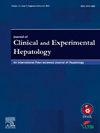非肝细胞癌肝移植:免疫检查点抑制剂的作用
IF 3.2
Q2 GASTROENTEROLOGY & HEPATOLOGY
Journal of Clinical and Experimental Hepatology
Pub Date : 2025-03-27
DOI:10.1016/j.jceh.2025.102558
引用次数: 0
摘要
结直肠癌(CRC)、胃肠胰神经内分泌肿瘤(GEP-NEN)和胆管癌(CCA)一旦转移到肝脏,发病率和死亡率都很高。肝移植(LT)是高度选择性患者治疗这些癌症的可行方法;然而,它们在晚期的侵袭性导致许多患者从移植名单中除名或需要进一步降低分期。免疫检查点调节剂的免疫治疗已经彻底改变了癌症研究。免疫检查点抑制剂(ICI)利用恶性细胞和调节性T细胞的慢性炎症状态和细胞毒性T淋巴细胞抗原4 (CTLA-4)和程序性细胞死亡蛋白1 (PD-1)/程序性细胞死亡配体1 (PD-L1)的过度表达,阻断免疫检查点并抵消肿瘤逃避免疫系统的能力。然而,同种异体移植物PD-L1和PD-1对浸润T细胞的相互作用是lt病例中移植物耐受的一种手段。因此,应用ICIs可能会阻断这种保护作用并诱导移植物排斥,这一现象在PD-1/PD-L1抑制ICIs中尤其明显。可以通过应用先进的生物标志物和指定某些突变来降低肝移植后移植排斥反应的风险,这些突变可以提高患者在肝移植前使用ICI的选择标准。此外,确定肝移植前后ICI给药的最佳间隔,确定肝移植后发生的新发恶性肿瘤的ICI适应症,以及早期排斥检测的生物标志物,为CRC、GEP-NEN或CCA患者更有希望的肝移植结果铺平了道路。因此,本综述旨在全面概述ICI治疗在非肝细胞癌移植肿瘤治疗中的作用,展示其在移植前和移植后的应用潜力,以及减少或及时发现ICI相关移植排斥反应的途径。本文章由计算机程序翻译,如有差异,请以英文原文为准。
Liver Transplantation for Non-hepatocellular Carcinoma: The Role of Immune Checkpoint Inhibitors
Colorectal cancer (CRC), gastroenteropancreatic neuroendocrine neoplasm (GEP-NEN), and cholangiocarcinoma (CCA) exhibit high rates of morbidity and mortality once metastasized to the liver. Liver transplantation (LT) is a viable therapeutic approach for these cancers in highly selected patients; however, their invasive nature at late stages causes many patients to be delisted from transplantation or to require further downstaging. Immunotherapy with immune checkpoint modulators has revolutionized cancer research. Immune checkpoint inhibitors (ICI) leverage the chronic inflammatory state and the overexpression of cytotoxic T lymphocyte antigen 4 (CTLA-4) and programmed cell death protein 1 (PD-1)/programmed cell death-ligand 1 (PD-L1) by malignant cells and regulatory T cells, to block immune checkpoints and counteract tumor's ability to evade the immune system. However, the interaction between allograft PD-L1 and PD-1 on infiltrating T cells functions as a means of graft tolerance in cases of LT. Therefore, the application of ICIs might block this protective effect and induce graft rejection, a phenomenon particularly observed in PD-1/PD-L1 inhibiting ICIs. The risk of post-LT graft rejection can be mitigated by applying advanced biomarkers and specifying certain mutations that enhance patient selection criteria for pre-LT ICI use. Furthermore, the determination of optimal intervals of ICI administration pre- and post-LT, identification of ICI indications in de novo malignancies occurring after LT, and investigation of biomarkers for early rejection detection, pave the way for more promising LT outcomes in patients with CRC, GEP-NEN, or CCA. Therefore, this review aims to illustrate a comprehensive overview of the role of ICI therapy in the management of non-hepatocellular carcinoma transplant oncology cancers by demonstrating the potential for its application in both pre-and post-LT states, and pathways to reduce or timely detect ICI-associated graft rejection.
求助全文
通过发布文献求助,成功后即可免费获取论文全文。
去求助
来源期刊

Journal of Clinical and Experimental Hepatology
GASTROENTEROLOGY & HEPATOLOGY-
CiteScore
4.90
自引率
16.70%
发文量
537
审稿时长
64 days
 求助内容:
求助内容: 应助结果提醒方式:
应助结果提醒方式:


